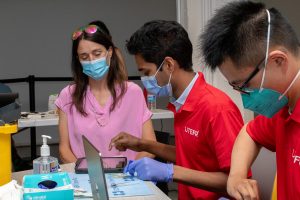“It was Exhilarating!”: U of T Students Become Lay Vaccinators
August 24/2022
By Heidi Singer and Françoise Makanda
When the first person walked through the door of the makeshift clinic on U of T’s St. George campus, half a dozen students in red polo shirts and purple medical gloves were sitting at long tables, waiting to make history.
Akash Kothari, a Master’s student in immunology, had been training and practicing for this moment. Akash reviewed the participant’s eligibility and consent, sterilized her upper arm, chose his target area, and plunged in the syringe. Afterwards, the woman gave a thumbs up, grinned through her mask, and the room erupted in applause. Kothari had quite possibly become Canada’s first “lay” student vaccinator.
“It was exhilarating,” recalls Kothari, a volunteer with U of T Emergency First Responders (UTEFR). “I wasn’t nervous – we were all trained extraordinarily well, and we were all very confident. “We showed that lay vaccination can work, and I think this has massive implications for our health system. I’m really happy to have been part of it.”
The team gave out a dozen Pfizer COVID-19 vaccinations to their fellow U of T students and community members that day in late July. They didn’t expect to make a dent in the caseloads that have contributed to the summer wave. But they hoped to show that trained lay people can deliver vaccines in Canada – and help relieve the immense pressures on health providers and health systems.
The clinic was developed by UTEFR’s Ryan Yee; Dr. Aaron Orkin, an associate professor at U of T’s Dalla Lana School of Public Health; and Cécile Raymond from the University Health Network’s COVID Team Vaccine, which coordinated the clinic and necessary supplies.
“The majority of vaccinations on this planet are not given by highly trained health professionals,” says Orkin, who practices public health with Toronto’s Inner City Health Associates and emergency medicine at Unity Health. “Canada is protective of the idea that even basic health procedures have to be done by health professionals. Canadian nurses, physicians and pharmacists are trained to do comprehensive and complex assessments. Having health professionals give vaccines all day is a tremendous de-skilling.”
Throughout the pandemic, the Ontario government has relied on health professionals to give vaccinations. The approach is costly and inefficient. Those doctors, nurses and pharmacists could have been using their skills to train and supervise teams of lay vaccinators, says Orkin.
“Anyone who’s taken a first aid course can be trained to give a vaccine safely and effectively,” he says. “At the height of the pandemic, pools were closed and thousands of lifeguards were sitting at home. Meanwhile we were trying to spin up vaccine clinics to deliver millions of doses by doctors, nurses and pharmacists. Now the health system is facing some of the worst human resources shortages they’ve ever seen. We need a different way of doing things.”
Change can be difficult and slow in Canadian health care – Ontario pharmacists have only been allowed to administer vaccines for less than a decade — but the disruption of COVID has presented new opportunities. Last year, Ontario amended its Regulated Health Professions Act to allow anyone to give a COVID vaccination under supervision by a physician, nurse or pharmacist.
The UTEFR students began training this past spring, learning how to deal with allergic reactions and use the provincial vaccination software. On the day of the clinic, they reviewed how to identify the deltoid muscle and give injections at a 90-degree angle, practicing first on oranges.
“It’s great that we’re giving people protection,” says Yee, a Master’s student in Biomedical Engineering. “But I think the bigger impact is going to come from showing that we can find a better way to distribute our healthcare resources.”

U of T student Akash Kothari prepares to administer a shot to Lori Seeton, Director of Integrated Covid Response & Recovery, University Health Network
The U of T clinic is believed to be Canada’s first student-led vaccinator effort, but it’s modelled on past successes offering peer services such as student sexual health education. The idea is to strengthen the resiliency of Canadian health systems. But organizers also believe that allowing trusted community members to provide the service will build trust for vaccination.
“Reaching out to a community requires voices, faces and contacts from that community,” said Orkin. “During the pandemic, we’ve seen peer workers and community health workers reach all communities but especially marginalized and underserved ones. Peer workers bridge the gap between health providers and communities but they haven’t given the vaccine themselves. There’s no reason why they can’t. It would help us further our reach.”
The team plans to study the pilot program, which will include future student clinics and similar peer vaccinator efforts in Toronto’s homeless shelters. He hopes the approach will be taken up on a mass scale for all healthy adults.
In Toronto alone, teams of healthcare professionals have delivered over seven million doses of COVID vaccines, says Lori Seeton, UHN’s Director of Integrated Covid Response & Recovery – and the clinic’s first participant.
“I am very excited for lay vaccinators to become a big part of our collective vaccination efforts” says Seeton. “Imagine a future where non-clinical vaccinators administer a significant portion of these doses! This initiative could free up a doctor, nurse or other healthcare professionals who could focus further on delivering other aspects of healthcare.”
Top photo: Esther Lim, Akash Kothari, Yi Zhu, Tom Joseph, Ryan Yee; Kneeling: Joe Salvo, Nerissa Feng